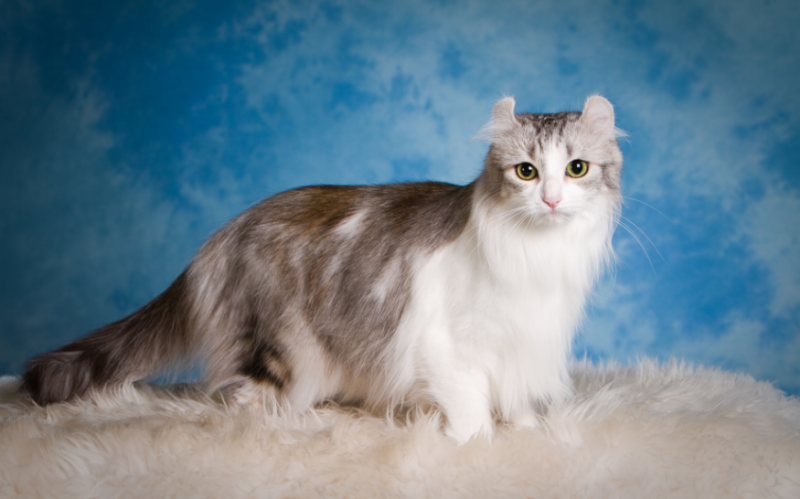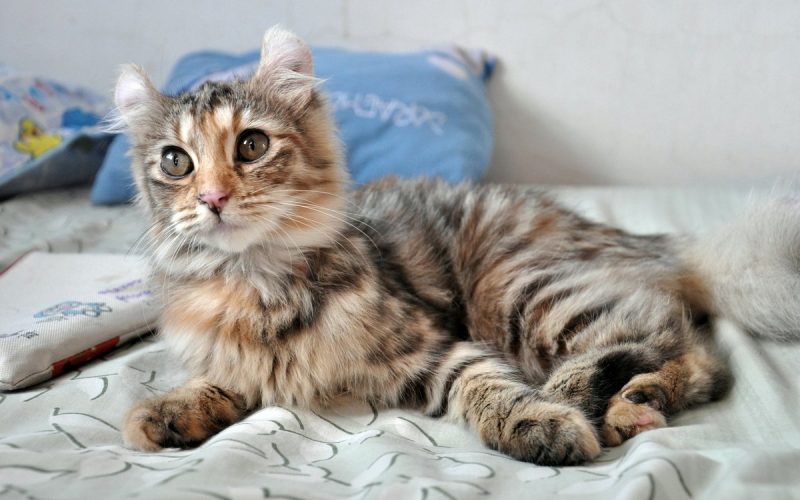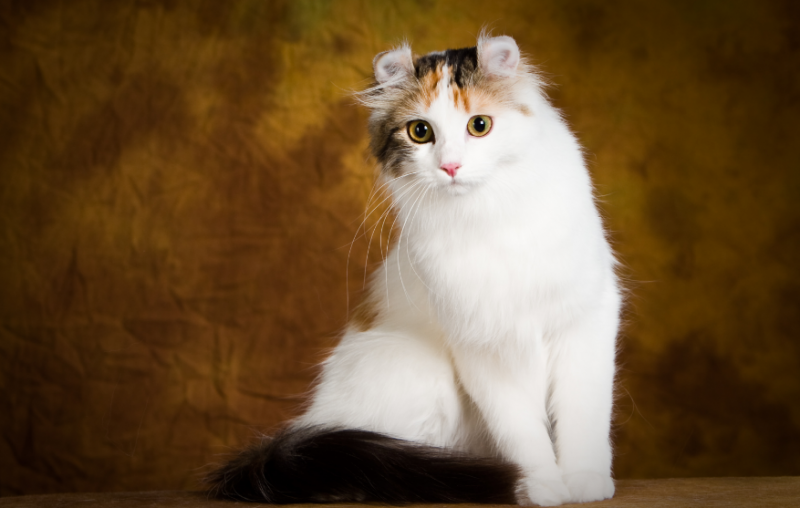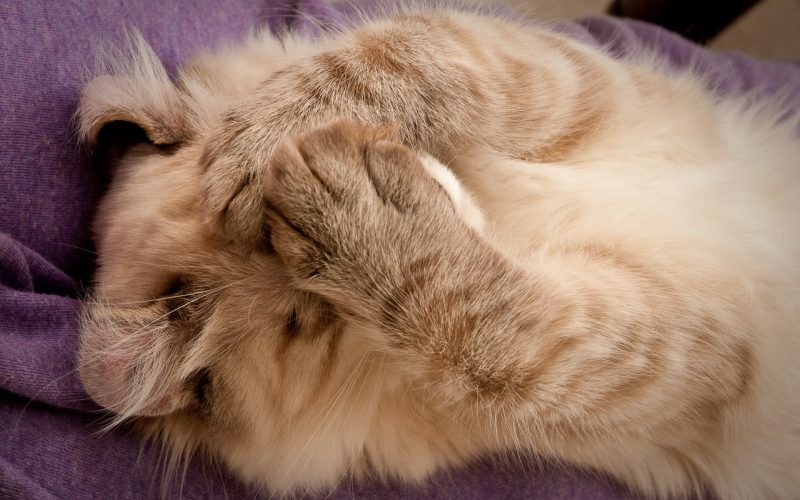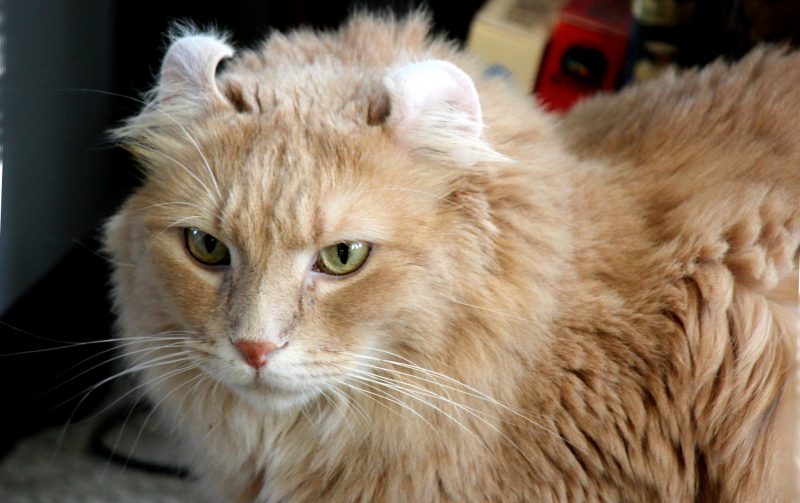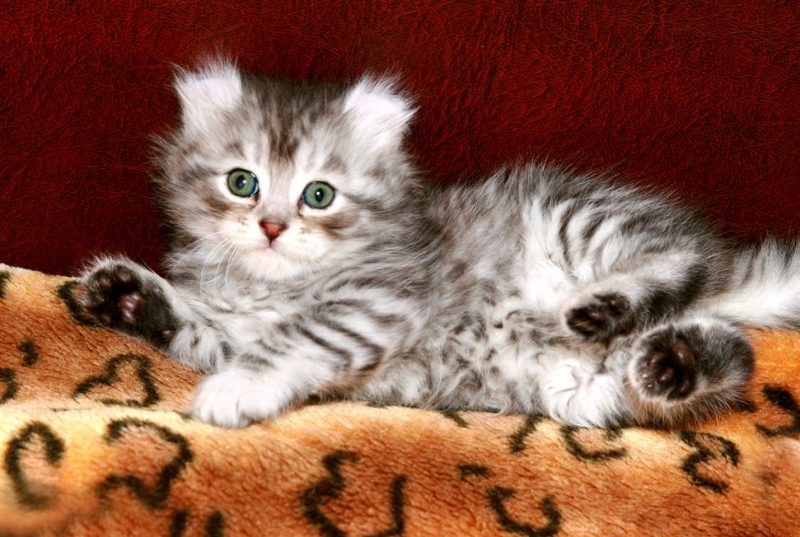One of the most amazing cat breeds is rightfully recognized as an American curl. The unusual appearance of these tailed creatures attracts the continued interest of potential owners. What is the difference between such cats from representatives of other breeds?
Material Content:
History of breed origin
The very name of the breed (Аmerican Сurl) hints that it appeared in the USA. This breed takes its source in the year 81 of the last century. Living in California, Lakewood, the Rug family found a black baby whose auricles looked very unusual. The animal turned out to be a female and was named Shulamith. Six months later, 4 kittens were born in her, two of them had the same unusual ears as their mother.
In 1983, professional breeders took up the selection of unusual animals. After studying about 400 kittens, scientists came to the conclusion that the gene for wrapped ears is truly unique.
Appearance and Standards
Description of the breed gives the clearest definition of a cat with unusual ears.
The American Curl of all breeds is considered the first recognized international organization CFA in the form of short-haired and semi-long-haired cats.
However, despite such differences, there is a breed standard that describes in detail the body structure of animals, and most importantly, their ears:
- The head has a wedge-shaped shape, the length of the muzzle is almost 1.5 times the width. The transition from the forehead to the nose is smooth.
- Ears - wide at the base, moderately large. The minimum degree of twist is 90 degrees, while only the tip should be wrapped.
- The eyes resemble the shape of a walnut, set wide.
- The body of curls has a rectangular shape, its length is 1.2 times the height in the shoulders.
- The limbs are of medium length, proportional to the body.
- Curl's tail is wide at the base and gradually tapering; it has flexibility.
- The coat is silky and soft. It is short, covering the whole body and tail, or half-long. Curls' undercoat is minimal.
- The color of the wool can be different: colorpoint, tabby, cake. A fur coat of curls can be plain or resemble the colors of Siamese cats.
- A curl weighs an average of 2.5 - 5 kg. Kittens are born with straight ears, which gradually twist in the first weeks and finally curl by 4 months.
It is interesting. Adult curls can have straight ears, which is considered a deviation from the standard. For individuals participating in competitions, bent ears are a necessary attribute.
Note. The American Curl is a breed that is not similar to any of the existing ones. Some people confuse these animals with Scottish fold cats, which is fundamentally wrong. Scots represent a different genetic case. The shape of their ears differs from the characteristic appearance of the curls.
Varieties, cat character
American Curls are unpretentious, well adapted to various living conditions. They are very playful and need personal space, toys. The owners appreciate these animals for their temperament - affectionate and companionable, they really love the human society and the touch of the owner's hands.
Extremely sociable, the curl cannot stand loneliness and gets along well with family members and pets. However, representatives of this breed are not very suitable for families with children, since the latter love to cuddle pussies, and this, in turn, can injure the tender ears of a curl.
Attentive and sensitive curls try to keep abreast of all events. So, they can accompany the owner during his walks in the shower or watch TV with him / read the newspaper. One should not be surprised to find the ubiquitous curl, for example, in a salad bowl.
Curls are more attached to people than to housing. For this reason, they are not afraid of moving and traveling, provided that they have nearby loved ones.
In their homeland, in the USA, curls are nicknamed nothing other than clown cats. And all because of his desire to always be in the spotlight, like artists in the circus arena.
Shorthair and semi-long-haired curl cats are equally in demand among potential owners. In this case, the owners should not worry about the intensity of the molt of the animal - because of their short undercoat, cats do not lose hair very abundantly. Both varieties are distinguished by a convivial and friendly character.
Features of care and maintenance
Caring for short-haired American curls and their half-long-haired counterparts is not very difficult. It is enough to comb these four-footed ones once a week. The most time-consuming process in terms of care is clipping. The owner can prevent injury to the animal and simplify the task by acquiring a special tool for cutting claws. It is acceptable to use anti-scratches.
Ears should be cleaned when plaque is formed from the inside. It is convenient to carry out the procedure using a special cleaning agent.
Attention! The procedure for cleaning the ears should be carried out as carefully as possible. Do not forget that the ears of the curl are a dense cartilage and should not be pulled or straightened during cleaning. In addition, the ears of these cats are very fragile and it is very easy to damage them.
American Curls are muscular and physically developed cats. They feel great in a spacious room, so a private house is ideal for them. Pets living in the apartment are allowed to walk on a leash several times a week.
These creatures, as a rule, relate very well to leashes, implicitly letting themselves skip.
These animals generally have a lot of dog habits, one of which is the desire to follow the owner everywhere. It is better to take walks in the garden or park, traveling along the asphalt and busy streets is best avoided. An inquisitive and playful curl can take a car for a living creature and rush to it with the goal of greeting. Such meetings can end sadly for a cat.
Pet Feeding Rules
American Curl cats should be fed exclusively with high-quality food, it is best to give preference to premium foods. Nutrition should be as balanced and dosed as possible.
High-quality dry food will allow you to well clean the teeth of cats from plaque. Ready food should be selected based on the age of the four-legged.
- Owners who decide to feed their pet natural food should consider that 80% of each serving is meat (lean). Cats with bent ears are happy to eat chicken, beef and rabbit.
- It is permissible to enter offal in the cat's menu.
- Curls should also eat vegetables, cereals (oats, rye, wheat), herbs, sea fish (boneless), dairy products.
- Vitamins should be given to animals.
Before six months, American Curl kittens should be fed 5 times a day, animals from 6 to 12 months - 3-4 times. After a year, curls eat twice and thrice a day, and adults eat in the morning and evening.
Breeding American Curls
To mate a curl, you need to choose a partner of the same breed or an outbred animal that is similar in standard. The “fresh blood” of domestic cats helps curls maintain their health and breed.
It is interesting. If two curls mate, their offspring will have bent ears. If one of the partners was “normal”, then half of the kittens will have twisted ears.
Newborn curls all have one straight ears, gradually bending over the next 10 days. And after a few months you can determine the quality of the cat (domestic, pedigree, exhibition). This factor is determined by the degree of ear curl. A small degree of bending makes the animals exclusively domesticated, while highly curled ears allow the kitten to subsequently become a breeding pattern. A perfect bend opens a kitten's door to the world of cat shows.
Note. Predicting the bend angle of the ears of the curl is almost impossible. In this case, the angle of curl of the ears of manufacturers does not matter. A pair with slightly curled ears can become the parents of the future winner of the exhibitions, while typical domestic kittens may appear from a pair of elite curls.
Health and Life Expectancy
The American Curl breed does not have characteristic genetic diseases. In this regard, they differ from fold cats, in which the structural features of the ears can lead to unpleasant health consequences.
However, curl owners should be attentive to the health of the pet, since it may have:
- helminthic invasion;
- allergy;
- cystitis;
- urolithiasis disease.
Note. The animal should not overeat. Otherwise, overweight and maintaining a sedentary lifestyle can lead to problems with the cardiovascular system.
Kitten selection and price
When choosing a curl kitten, several recommendations should be considered:
- The American curl is not a very common breed in Russia and the CIS countries. Therefore, the choice of a breeder should be taken very seriously. The latter must provide the potential buyer with all the documents of the baby and give information about one of his parents.
- The room in which the kittens are kept should be clean and warm.
- Going to choose a baby curl, you should familiarize yourself with the breed standard in order to prevent the purchase of a defective specimen.
- Three-month-old kittens should be energetic, as well as accustomed to food and toilet.
- The coat of babies should be shiny and clean, just like the organs of hearing and vision.
- A tight and tight belly of the crumbs may indicate the presence of worms in it.
Tip. It is best to purchase kittens whose age has reached 4 months. It was by this time that the Curls' business card was fully formed - ears bent up.
As for the price of these unusual cats, it may vary depending on the type of animal:
- Kittens pet. Sold exclusively for home use, not suitable for exhibitions and competitions. Their cost usually does not exceed $ 100.
- Cats brid. They can participate in the breeding process, but due to some deviations from the standard, they are not suitable for exhibitions. Estimated cost - up to $ 500.
- Curls show. Animals that meet the maximum standards are endowed with all the necessary qualities. Their cost starts from $ 2000.
Charming and amazing curls are a real decoration of the home. Their funny twisted ears can cheer up any person. Peaceful and affectionate disposition make these cats the favorites of each member of the family.


